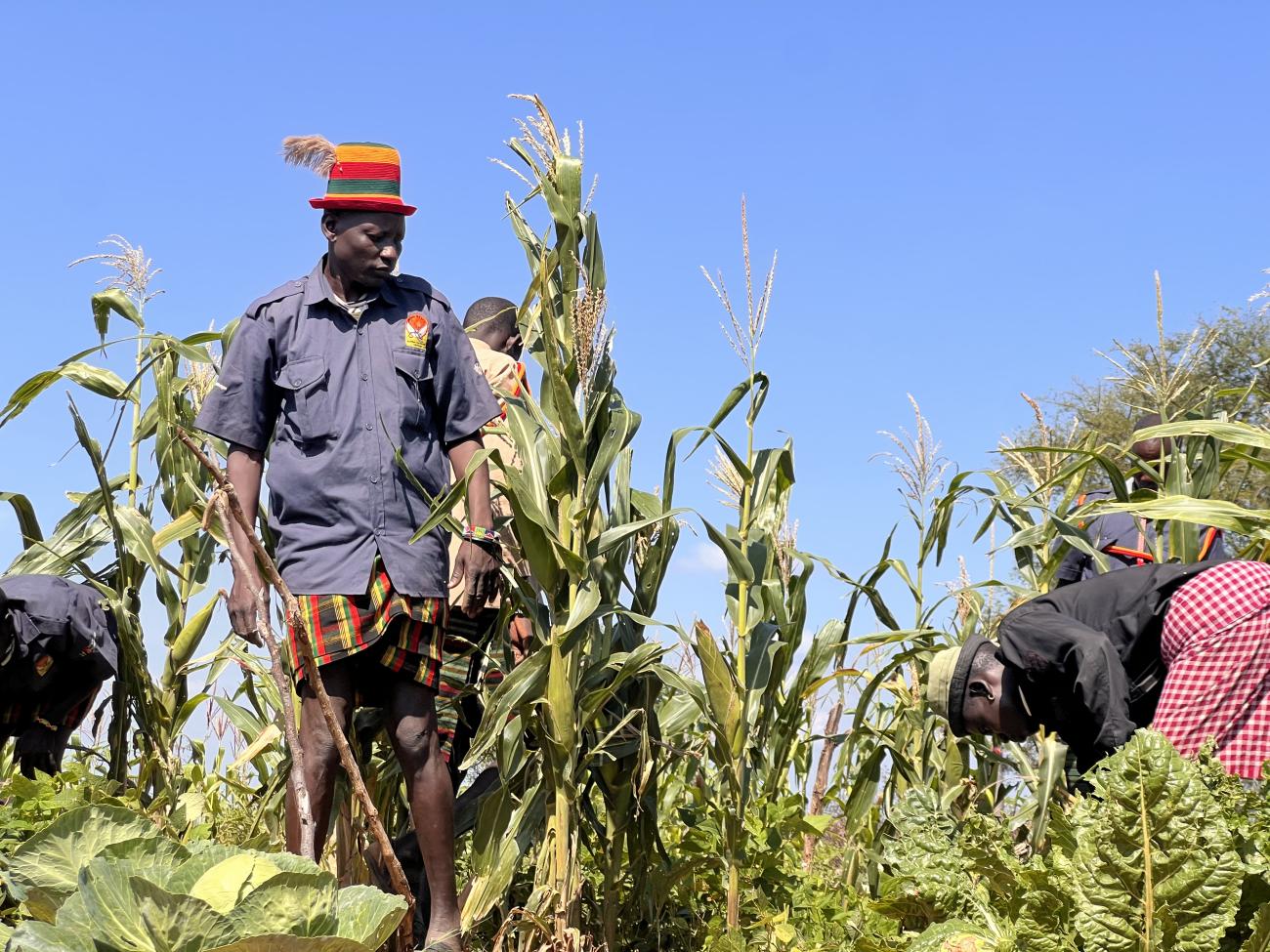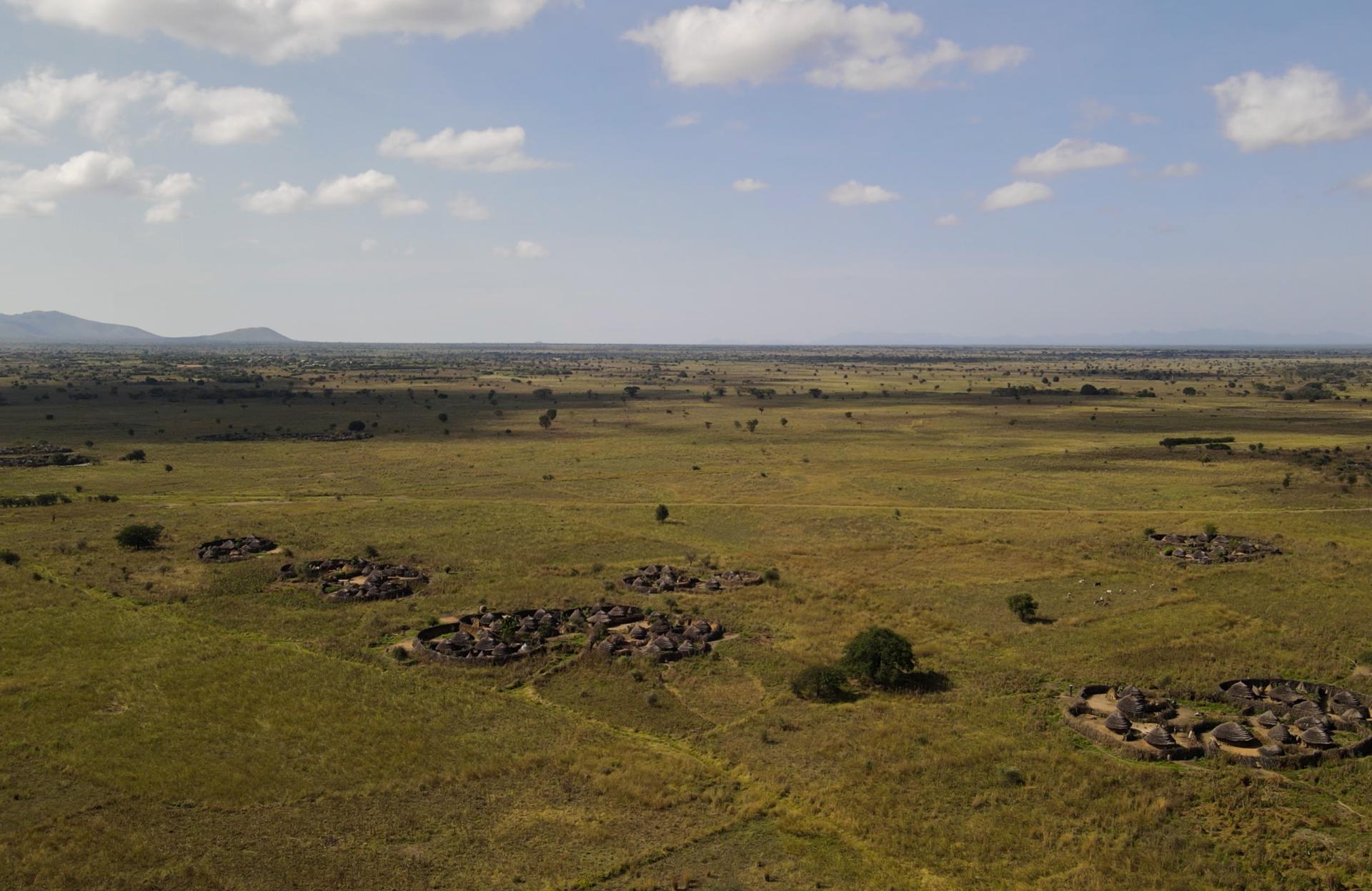
By Francesco Torri
“We were raised as warriors. It’s part of our culture, but there has been too much bloodshed. Now, we fight for peace,” says Simonpeter, a young ex-combatant from the Jie ethnic group, known as Karachuna in the local language.
It’s a cloudy, late afternoon in the semi-arid savannah of Kotido district in Karamoja, Uganda, where 10 young ex-warriors are finishing collecting an abundant harvest of sorghum. Simonpeter, the oldest member, explains that two years ago at this time, they would be hidden in the bush with arrows and Kalashnikovs, preparing for a raid. They are excited when talking about it, and they laugh when one of them starts moving as if he were in the bush.
“As the number of guns rose again in 2019, [gunfire] exchange became more frequent among raiders and the risk of dying during cattle raids got increasingly higher,” says Jhon, Project Assistant at the local organization Justice and Peace Department of Kotido. “And even if in Karimojong culture losing [one’s] life during a raid is considered an honor, the desire for peace quickly [replaced] this traditional idea as the escalation of violence became unbearable.”

Karachunas simulating a raid.
For almost five years, until the end of 2024, cattle raiding surged in the region, interrupting a period of relative peace that had lasted 13 years, but during which the real drivers of cattle raiding were left unaddressed. “Karimojongs are cattle raiders by tradition. It’s a practice embedded in culture, a ritual, something we identify with and that we are proud of,” explains Gabriel, an ex-Karachuna from the village of Loletio, near Kotido. “Raids have always been a way to gain social respect, and the only way to pay for a marriage for many of us,” he says.
Since the fall of Amin’s regime in 1979, the number of guns in the region grew exponentially as the armories of Kotido and Moroto were plundered by Karimojong warriors, who stole more than 10,000 rifles, including Kalashnikovs. This episode transformed cattle raiding into violent, inter-Tribal warfare and led to extreme insecurity levels in Karamoja that lasted for decades.
Until the early 2000s, the government paid limited attention to the security situation in Karamoja, tackling it with heavy-handed approaches that were marred by rampant human rights violations. Such marginalization and institutional neglect exacerbated the conditions of extreme poverty and malnutrition already present in the region. Then, in 2006, the first voluntary disarmament campaign was started by President Museveni, who gave amnesty to all warriors who voluntarily returned their weapons. “In this way, thousands of guns were removed from the region, and this led to a significant reduction in the number and intensity of conflicts in Karamoja,” explains Charles Ichogor, Resident District Commissioner of Kotido.
Young woman harvesting sorghum.
However, the government failed to provide alternative means of subsistence for the newly disarmed men, nor socioeconomic reintegration programs or climate change adaptation strategies, and the levels of poverty and food insecurity worsened exponentially.
The root causes of cattle raiding remained unaddressed for years, and in late 2018, violence progressively resurfaced. Conditions were further worsened by the COVID-19 pandemic, when the lack of access to basic subsistence led to skyrocketing levels of economic insecurity, and raids became increasingly more frequent. Cattle raiding came back as the main source of livelihood for most communities, and the leading source of poverty and death for many others. As reported in a 2022 article in The New Humanitarian, more than 500 people have died since 2019 due to cattle raiding.
During this era, the Uganda People Defence Forces implemented Operation Usalama Kwa Wote, which included a new strategy to address raiding using paid informants within the community. The social fabric of Karimojong communities quickly eroded as raiders started targeting and killing those who were suspected of being informants. Along with its informant-based campaign, the government continued implementing a shoot-at-first-sight policy against suspected raiders. In June 2023, the UPDF transitioned to a new strategy based on voluntary disarmament, facilitated by the presidential amnesty granted to the raiders. This allowed non-governmental actors to get involved, offering alternative livelihoods to ex-combatants.

Karamojong villages seen from above.
The Justice and Peace Department of the Catholic Diocese of Kotido (JPD-K) has been leading the way in supporting disarmament since then, fostering inter- and intracommunal dialogues to build lasting peace agreements and creating socio-economic and psychosocial reintegration programs for ex-Karachunas.
Nicola Carradori, Coordinator of JPD-K, says they facilitate weekly dialogues and mediation sessions among Jie, Dodoth, Turkana, and Acholi communities, and practical field training. “Peace is built by bringing about a change of mindset among Karachunas: from warriors to members of a peaceful community. To be part of a community disarmament alone isn’t enough. Karachunas need another way to sustain themselves; otherwise they would just go back to raiding,” she says.
To achieve such reintegration, the JPD-K is supporting over 650 ex-combatants to access sustainable income-generating activities like regenerative agriculture, agroforestry, and beekeeping, agro-pastoral field schools, distribution of tools and seeds, literacy classes, and dialogue processes. Participants who show commitment and work as a group continue receiving support. “We are supporting a process of change aimed at creating real and stable alternatives for young Karamojong,” says Nuria Teko, vice chairperson of the District of Kotido.
Elder talking at a peace dialogue near Kotido.
Agriculture in Karamoja has historically never moved beyond basic subsistence and has always faced major challenges. The lack of adequate tools and harsh climatic conditions has kept local communities from turning farming into a real source of income. Karamoja is an extremely arid region with very low annual rainfall. During the rainy season, fields are at high risk of flooding, while water collection options remain limited. For this reason, the Karimojong have evolved to be semi-nomadic shepherds; pastoralism is the way of life best suited to the semi-arid islands of the Karamoja. “To farm here, you need skills and equipment that simply didn’t exist before the JPD-K demobilization and reintegration program,” Ichogor says.
Today, thanks to drought-resilient practices, micro-scale irrigation, and the distribution of seeds that are more suitable for the local climate, Karachunas are managing to commercialize agricultural products. “Some of these groups have already collected between 25 and 40 bags of sorghum this year, which can yield, once sold, between 5 and 10 million Ugandan shillings, so more than 2,000 Euros,” says Peter Lopuko, Project Officer of JPD-K. A tractor purchased in May by JPD-K additionally allowed 23 communities of former combatants—thousands of people—to cultivate their sorghum fields, the region’s main crop.
“Peace is still fragile in the region and efforts need to continue if we want to prevent insecurity levels from rising again,” says Gabriel, an ex-Karachuna who is now part of the JPD-K reintegration program. “But change is visible,” he continues. “Groups that once shot at each other now sit in the same circle. Ex-raiders speak on local radio, encouraging others to lay down arms. And community fields are being restored in areas long affected by violence.”
--Francesco Torri is a freelance environmental journalist, photographer, and video-maker from Italy. He spent the last three years investigating socio-environmental conflicts related to extractivism in Latin America, with a focus on strategic metals and minerals demanded for the "green" energy transition. Follow Francesco Torri on Instagram at @resistance_voices.
Top photo: Karachunas harvesting at the regenerative garden of JPD-K.

